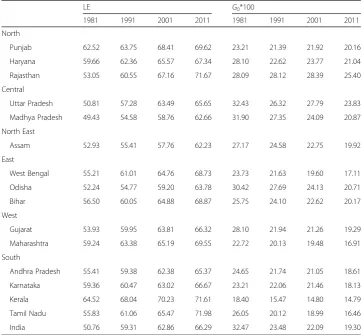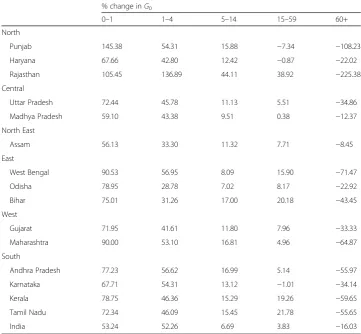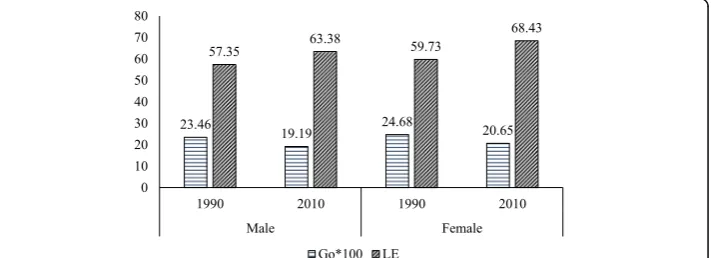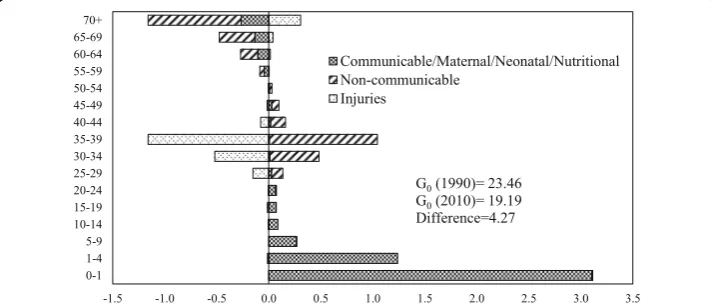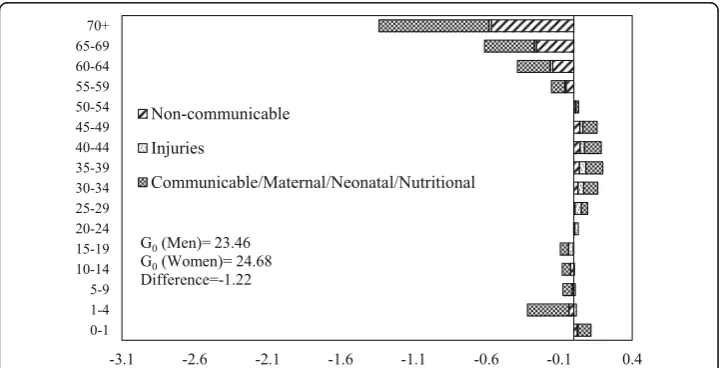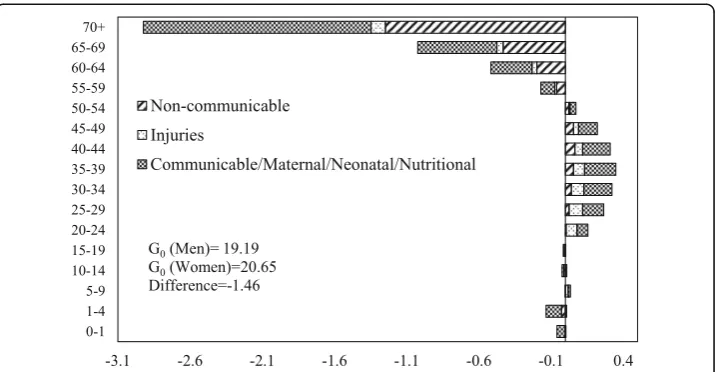O R I G I N A L A R T I C L E
Open Access
Trends in inequality in length of life in
India: a decomposition analysis by age and
causes of death
Abhishek Singh
1*, Ankita Shukla
2, Faujdar Ram
2and Kaushalendra Kumar
1* Correspondence: abhi_iips@yahoo.co.in
1Department of Public Health &
Mortality Studies, International Institute for Population Sciences, Mumbai 400 088, India Full list of author information is available at the end of the article
Abstract
Background:Studies dealing with trends in inequality in length of life in India are rare. Studies documenting the contribution of age and causes of death to the inequality in length of life are more limited.
Objective:The study aims to examine the trends in inequality in length of life in India and 15 major states of India and to decompose the inequality in length of life into the contributions of age and causes of death.
Method:We use life table Gini coefficient (G0) to measure the inequality in length of
life. We use the formulae developed by Shkolnikov, Andreev, and Begun (DR 8(11): 305–358, 2003) to decompose the differences between Gini coefficients by age and cause of death.
Result:TheG0for men has declined from 0.32 in 1981 to 0.19 in 2011. For women, G0has decreased from 0.31 in 1981 to 0.22 in 2011. Mortality decline in the age
group 0–1 year has contributed most to the decrease inG0. In contrast, mortality
decline in 60+ has tended to increase theG0. The state-wide variations in the
age-specific contributions to decrease inG0were stark. The contribution of
noncommunicable diseases to the male-female gap inG0has increased between
1990 and 2010. Injuries at ages from 20 to 39 years also contributed to the male-female difference inG0in 2010.
Conclusion:Future studies must analyze inequality in life expectancy for assessing the performance of societies regarding length of life.
Contribution:This is the first study that provides compelling evidence on inequality in length of life in India and its major states.
Keywords:Inequality in length of life, Decomposition by age and causes of death, Gini coefficient, Sample Registration System, Global Burden of Disease Study, India
Introduction
Life expectancy at birth (both sexes combined) in India has risen from 54 years in 1981 to 67 years in 2011(RGI 2013). Although the life expectancy has increased, the increase is not uniform across the different states and subpopulations of India. For example, life expectancy for males rose from 54 years in 1981 to 66 years in 2011. For females, it increased from 54 years to 69 years during the same period. Different states of India depict significant variations in trends in life expectancy at birth, with
differences often years or more between individual states. Such trends in life expectancy at birth reveal widespread inequality in length of life.
Previous research also suggests that apart from socioeconomic, regional, and biological factors, there are some intangible factors which affect individual’s life expectancy irrespective of the group to which the individual belongs (Edwards and Tuljapurkar 2005; Wolfson and Rowe 2001). Even if all conditions are constant, not everybody dies at the same age, and consequently there may be inequality in length of life among individuals within subgroups. Hence, the level of life expect-ancy alone cannot provide the complete picture of mortality situation in a popula-tion. For all these reasons, it is important to examine the inequality in length of life systematically. Moreover, it is also important to understand the changes in inequality in length of life.
Systematic evidence on trends in inequality in length of life mostly comes from the high-income countries. Wilmoth and Horiuchi (1999) found that the Inter Quartile Range (IQR) fell dramatically in the U.S., Sweden, and Japan during the epidemiological transition after 1870, and flattened after 1950. However, the trends in life expectancy and inequality in life expectancy did not show the same patterns. Another study based on high-income countries showed that the variance in adult length of life fell rapidly during the epidemiological transition but remained stag-nant afterward, with large differences across countries (Edwards and Tuljapurkar 2005). Smits and Monden (2009) in their study of high-income countries find large differences across countries in the level of within-country inequality in adult length of life. Shkolnikov et al. (2003) have also estimated the inequality in length of life for 32 countries in 1996–1999 and the associated changes in Gini coefficient in Japan, Russia, Spain, USA, and UK in 1950–1999.
Union Territories (UTs). The various States and UTs are at different levels of so-cioeconomic development. For example, the southern states—like Andhra Pradesh, Telangana, Karnataka, Kerala, and Tamil Nadu—are way ahead of other States in socioeconomic development. Also, various States/UTs are at different levels of demographic and epidemiological transitions. Therefore, an analysis of India and its states is likely to provide interesting patterns in inequality in length of life. Having said that, the present study examines the trends in inequality in length of life. Moreover, the present study also decomposes the changes in inequality in length of life into the contribution of mortality change in different age groups. Finally, we decompose the changes in inequality in length of life into the contribu-tion of causes of death. We use time-series data from the India’s Sample Registra-tion System and the Global Burden of Disease Study 1990 and 2010 to fulfil the objectives of the paper.
Data and methods
We use data from the Sample Registration System (SRS) for the period 1981–2011 to examine trends in inequality in length of life in India and 15 major states of India. Sample Registration System (SRS) under the aegis of the Office of the Registrar-General of India (RGI) is the primary and continuous source of data on mortality and life tables for India and 16 major states. These states are Himachal Pradesh, Punjab, Haryana and Rajasthan (all from the north), Uttar Pradesh and Madhya Pradesh (from the central), Assam (from the Northeast), West Bengal, Odisha and Bihar (from the east), Gujarat and Maharashtra (from the west), and Andhra Pradesh, Karnataka, Kerala and Tamil Nadu (from the south). One of these 16 states, Himachal Pradesh, could not be included in the analysis as the data is deficient for Himachal Pradesh for the years 1980, 1981, and 1990. Hence, we re-strict our analysis to India and 15 major states of India.
In SRS, the enumerators match the recorded vital events (as and when they occur) in a representative sample of rural and urban units with those from a bi-annual retrospective survey by independent supervisors (RGI 2013). The SRS pro-vides information on age-specific death rates in different age groups up to 70+ starting from the year 1970. The SRS in the year 1995 disaggregated the age group 70+ into 70–74, 75–79, 80–84, and 85+ year age groups. Along with this, RGI also provides abridged life tables based on SRS data for 5-year periods start-ing from 1970 to 1975. Since the SRS-based life tables in the late 1990s and early 2000s are marked by inconsistencies in the age groups 1–4 (Saikia et al. 2010), we do not borrow the life expectancies from those life tables for our analysis. Instead, we use age-specific death rates published by the SRS to generate new life tables for our analysis.
broad classification of the GBD study, we categorize the causes of deaths into three major categories: communicable, maternal, neonatal and nutritional conditions; noncommunicable diseases; injuries (GBD 2013).
Measuring inequality in life expectancy
A wide array of statistics has been used by different researchers to measure inequality: interquartile range (IQR), variance (VAR), standard deviation (STD), the Theil entropy index (T), Gini coefficient, etc. Among them, Gini coefficient is considered as the most useful measure of inequality in length of life. As a formal construct, Gini coefficient has significant similarities with life expectancy, which allow applying similar methods for its calculation or decomposition (Shkolnikov et al. 2003).
Gini coefficient represents cumulative income share as a function of cumulative population share. Applying this device to mortality-by-age schedules, one can im-agine a person’s years lived from birth to death to be “income” and cumulative death numbers to be “population”(Shkolnikov et al. 2003). The coefficient varies from “0” to “1”. It is equal to “0” if all people die at the same age and “1” if all individuals die at age “0” and one individual dies at an infinitely old age. Greater or lower values of Gini coefficient show a greater or lower magnitude of interindividual differences in length of life.
According to Hanada (1983), Gini can be defined as:
G0¼1−
1 e0:
Z ∞
0 ½lðxÞ 2
dx
A compact expression for the life table Gini by Hanada (1983) in its discrete form (Shkolnikov et al. 2003) is especially useful for practical calculations.
Gx¼ 1− 1 exlx
Xw−1
t¼x ðltþ1Þ
2þ
A‘x lð Þt 2− ðltþ1Þ2
ð1Þ
whereA‘x¼
1−ð2=3ÞqxþCx ð2−qx−ð6=5Þ CxÞ
½
2−qx
½ ð2Þ
Cx¼ Ax−1=2
Ax¼ L1x −lxþ1
lx−lxþ1
Formula (2) would not work in a proper way for x= 0 because during the first year of life l(x) falls much steeper than it can be predicted by a quadratic polynomial. The use of the formula by Bourgeois-Pichat (1951) solves the problem for age 0 and results in
A‘0¼ A0 1−q0
3þ0:831A0
2þq0
They used single-year mortality data starting from 85 to 110 years for estimatingA`85+. The equation estimated by Shkolnikov et al. (2003) for obtainingA`85+is given below:
A‘85þ¼
1=ðl85Þ2 X109
x¼85 ½ðlxþ1Þ
2 þ
A‘x ððlxÞ2− ðlxþ1Þ2Þ ð3Þ
Substituting the valueslx,Ax, andA`xin formula (3) Shkolnikov et al. (2003) obtained the following equations forA`85+.
A‘85þ ¼−0:440þ0:680e85ðfor womenÞ;
A‘85þ¼−0:227þ0:626e85ðfor menÞ
ð4Þ
The SRS until the year 1994 used to provide age-specific death rates for broad 5-year age group, the last age being 70+. From the calendar year 1995, the SRS has extended the last age group to 85+. Hence, to carry out a trend analysis, we made the last age group as 70+ for all the years included in the study. Then we used the single-year mortality data starting from age 70 to 110 years obtained from the 334 life tables from the Berkeley Mortality Database to esti-mateA`70+. We used formula (3) to estimateA`70+. The equations forA`70+are given below:
A‘70¼ −2:104þ0:860e70ðfor womenÞ;
A‘70¼−1:336þ0:780e70ðfor menÞ
ð5Þ
Finally, we used Eqs. (4) and (5) on SRS datasets for the years 1995 and later to examine whether the two equations yield substantially different results. The Gini coeffi-cients obtained from the two equations were close. Since the differences between the two coefficients were minimal, we used formula (5) to estimateA`70.
Decomposition of Gini coefficient by age groups
Shkolnikov et al. (2003) have developed a new formula for the decomposition of differ-ences between Gini coefficients by age and causes of death. The general procedure for decomposition by age of a difference in two Gini coefficientsG0andG`0is
δ¼G0−G‘0¼G0M½xiþ1G0M½xi
where M [xi] is a vector of age-specific mortality rates with elementsm`x for x< = xi and mx for x > =xi. It determines a stepwise replacement of one mortality schedule by another one, beginning from the youngest to the oldest age group.
Decomposition of Gini coefficient by causes of death
Let δ(xi,xi+n) is the absolute change in G0 due to age group (xi, xi+n), mxi|xi+n, j and m`xi|xi+n,j are the jth cause-specific death rates for age group (xi, xi+n) then age- and cause-specific change in Gini coefficient is given by(Shkolnikov et al. 2003).
δðxi;xiþnÞ jj ¼
mðxi;xiþnÞjj−m‘ðxi;xiþnÞjj mðxi;xiþnÞ−m‘ðxi;xiþnÞ
δðxi;xi þ nÞ
Results
substantially in India in the past three decades. For men, it has risen from 51 years in 1981 to 66 years in 2011, and for women, it has increased from 55 years in 1981 to 71 years in 2011. On the contrary,G0of life expectancy registered a decline during this period. For men, G0declined from 32 in 1981 to 19 in 2011. Similarly, for women, the
G0shows a reduction of 9 points. The state-level analysis suggests that theG0for men in 1981 is highest in Uttar Pradesh (32) and lowest in Kerala (18). Interestingly, the state-level variations in G0 narrowed down over the decades. In 2011, the G0 for Karnataka, Maharashtra, and Kerala is substantially lower than the national average. In comparison, the G0 for Haryana, Rajasthan Uttar Pradesh, Madhya Pradesh, and Odisha is substantially higher than the national average. The picture is similar for women. Notably theG0s were higher for women than for men.
Tables 3 and 4 present the age-specific contributions to the decrease in G0between 1981 and 2011 in India and 15 major states for men and women. At the all India level, the mortality decline in the age group 0–1 year contributed to 53% of the decline inG0 for men. Furthermore, the mortality decline in the age group 1–4 reduced the G0by 52%. For women, the mortality decline in the age group 0–1 year contributed to 55% of the decline in G0. The mortality decline in the age group 1–4 further reduced theG0 by 49%. Interestingly, the mortality decline in the age group 60+ tended to increase the
Table 1Life expectancy (LE) at birth and Gini coefficient of LE from 1981 to 2011, India and major
states, men
LE G0*100
1981 1991 2001 2011 1981 1991 2001 2011
North
Punjab 62.52 63.75 68.41 69.62 23.21 21.39 21.92 20.16
Haryana 59.66 62.36 65.57 67.34 28.10 22.62 23.77 21.04
Rajasthan 53.05 60.55 67.16 71.67 28.09 28.12 28.39 25.40
Central
Uttar Pradesh 50.81 57.28 63.49 65.65 32.43 26.32 27.79 23.83
Madhya Pradesh 49.43 54.58 58.76 62.66 31.90 27.35 24.09 20.87
North East
Assam 52.93 55.41 57.76 62.23 27.17 24.58 22.75 19.92
East
West Bengal 55.21 61.01 64.76 68.73 23.73 21.63 19.60 17.11
Odisha 52.24 54.77 59.20 63.78 30.42 27.69 24.13 20.71
Bihar 56.50 60.05 64.88 68.87 25.75 24.10 22.62 20.17
West
Gujarat 53.93 59.95 63.81 66.32 28.10 21.94 21.26 19.29
Maharashtra 59.24 63.38 65.19 69.55 22.72 20.13 19.48 16.91
South
Andhra Pradesh 55.41 59.38 62.38 65.37 24.65 21.74 21.05 18.61
Karnataka 59.36 60.47 63.02 66.67 23.21 22.06 21.46 18.13
Kerala 64.52 68.04 70.23 71.61 18.40 15.47 14.80 14.79
Tamil Nadu 55.83 61.06 65.47 71.98 26.05 20.12 18.99 16.46
G0during this period. Mortality decline in 60+ age group contributed to 16% and 33% increase inG0for men and women during 1981–2011 respectively.
The state-wide variations in the age-specific contributions to decrease inG0are stark. The contribution of the mortality decline in the age group 1–4 for men ranged between as high as 137% in Rajasthan and as low as 29% in Odisha. For women, this contribu-tion ranged between 250% in Kerala and 36% in Odisha. Likewise, the contribucontribu-tion of the age group 0–1, for both men and women, also varied considerably across the states. For men, it ranged between as low as 56% in Assam and as high as 145% in Punjab. For women, the contribution of 0–1 year varied between as low as 30% in Rajasthan and as high as 270% in Kerala. Like India, the decline in mortality in the 60+ age group tended to increase the G0for both men and women in the 15 major states. However, the magnitude of increase is significantly different in men and women in various states. For example, in Kerala women, the decline in mortality in 60+ contributed to 639% in-crease inG0during 1981–2011. In comparison, the contribution of decline in mortality in 60+ to increase inG0for Kerala men is only 60%.
Figures 1 and 2 indicate the pattern of association betweenG0and the life expectancy at birth for men and women respectively. The results show a negative relationship be-tween life expectancy at birth andG0, thus indicating that an increase in life expectancy at birth is accompanied by a decrease in inequality in length of life. The relationship is
Table 2Life expectancy (LE) at birth and Gini coefficient of LE from 1981 to 2011, India and major
states, women
LE G0*100
1981 1991 2001 2011 1981 1991 2001 2011
North
Punjab 63.53 67.39 67.65 75.18 26.92 23.59 23.43 21.37
Haryana 57.31 63.63 69.46 72.22 29.65 25.00 27.75 23.20
Rajasthan 54.69 58.85 63.20 65.62 32.22 23.74 23.47 20.23
Central
Uttar Pradesh 48.38 55.65 61.06 66.93 38.75 30.59 28.71 24.18
Madhya Pradesh 49.33 54.16 59.87 66.40 34.54 30.06 27.60 22.92
North East
Assam 52.43 55.46 60.04 65.55 29.49 25.83 25.71 22.25
East
West Bengal 55.71 62.12 68.10 72.96 26.95 22.95 21.08 19.88
Odisha 51.30 53.90 61.64 67.45 31.06 29.85 25.40 22.43
Bihar 48.89 58.87 65.95 68.16 33.11 27.73 25.24 19.54
West
Gujarat 57.37 63.43 69.05 72.65 29.70 24.62 25.13 23.04
Maharashtra 60.89 65.17 69.17 74.92 25.72 22.40 20.99 18.92
South
Andhra Pradesh 58.62 62.34 67.64 71.80 25.93 22.27 22.24 21.48
Karnataka 60.70 64.70 69.92 72.20 26.30 23.92 23.21 19.73
Kerala 70.19 74.73 77.01 79.33 19.05 16.46 17.27 18.48
Tamil Nadu 56.18 64.00 69.13 68.83 27.25 20.95 20.15 17.27
similar for men and women. The correlation coefficient between life expectancy at birth and Gini coefficient by states is −0.79 for men and−0.88 for women. Same life expect-ancies for many states correspond to different levels of Gini coefficients. For example, for men, the life expectancy at birth in Kerala and Rajasthan were 71. 6 years in 2011. However, the Gini coefficients are 14.8 and 25.4 respectively. Likewise, for women, the life expectancy at birth in Karnataka and Haryana was 72.2 years in 2011. But the Gini coefficients for these two states are 19.7 and 23.2 respectively. The Gini coefficients for the men population are substantially higher than those predicted by life expectancy at birth in Rajasthan in years 2001 and 2011 and in Uttar Pradesh in the year 2001. For women population, the Gini coefficient is substantially higher than that predicted by life expectancy at birth in Haryana in the year 2001. In comparison, the Gini coefficient was lower than the predicted value in Tamil Nadu in 2011.
Data from the Global Burden of Disease study (GBD) also shows a decline in G0 values for both men and women during 1990–2010. For men, the G0declined from 23 to 19. Similarly, for women, it declined from 25 in 1990 to 21 in 2010. While women have the upper hand in life expectancy at birth, the G0 is higher for women than men in both the rounds. Moreover, the male-female gap in G0 has widened between 1990 and 2010 indicating increasing sex differential in inequality in life expectancy at birth (Fig. 3).
Table 3Age-specific contributions to the decrease in Gini coefficient between 1981 and 2011,
India and major states, men
% change inG0
0–1 1–4 5–14 15–59 60+
North
Punjab 145.38 54.31 15.88 −7.34 −108.23
Haryana 67.66 42.80 12.42 −0.87 −22.02
Rajasthan 105.45 136.89 44.11 38.92 −225.38
Central
Uttar Pradesh 72.44 45.78 11.13 5.51 −34.86
Madhya Pradesh 59.10 43.38 9.51 0.38 −12.37
North East
Assam 56.13 33.30 11.32 7.71 −8.45
East
West Bengal 90.53 56.95 8.09 15.90 −71.47
Odisha 78.95 28.78 7.02 8.17 −22.92
Bihar 75.01 31.26 17.00 20.18 −43.45
West
Gujarat 71.95 41.61 11.80 7.96 −33.33
Maharashtra 90.00 53.10 16.81 4.96 −64.87
South
Andhra Pradesh 77.23 56.62 16.99 5.14 −55.97
Karnataka 67.71 54.31 13.12 −1.01 −34.14
Kerala 78.75 46.36 15.29 19.26 −59.65
Tamil Nadu 72.34 46.09 15.45 21.78 −55.65
Table 5 shows the age-specific contributions to the difference in G0 for men and women in India in 1990 and 2010. In 1990, the male-female difference in mortality in the age 60+ contributed to 107% of the male-female gap inG0. In 2010, this contribution in-creased to 164%. The male-female gap in mortality in the age group 0–1 decreased the male-female gap inG0in both 1990 and 2010. However, the contribution of male-female mortality gap in the age group 0–1 year declined between 1990 and 2010. In 1990, the contribution of 1–4 age group was also substantial. However, in 2010, the contribution of
Table 4Age-specific contributions to the decrease in Gini coefficient between 1981 and 2011,
India and major states, women
% change inG0
0–1 1–4 5–14 15–59 60+
North
Punjab 76.77 51.93 10.86 16.27 −55.84
Haryana 68.07 62.75 10.27 20.50 −61.59
Rajasthan 29.58 48.09 10.68 9.79 1.86
Central
Uttar Pradesh 48.83 45.11 8.63 11.01 −13.58
Madhya Pradesh 45.28 51.23 12.35 13.03 −21.89
North East
Assam 48.48 38.65 15.09 26.30 −28.51
East
West Bengal 60.27 56.60 13.50 34.10 −64.46
Odisha 71.01 36.48 12.64 18.13 −38.27
Bihar 48.82 43.72 10.80 16.88 −20.23
West
Gujarat 77.94 37.34 15.28 22.23 −52.78
Maharashtra 59.28 49.69 11.01 21.55 −41.53
South
Andhra Pradesh 63.04 75.40 22.58 29.35 −90.36
Karnataka 38.08 53.68 16.66 19.84 −28.27
Kerala 270.39 250.41 68.64 149.24 −638.69
Tamil Nadu 53.80 45.75 10.10 10.62 −20.27
India 55.35 49.04 11.94 17.15 −33.48
age group 1–4 reduced to only 8%. Notably, in 1990, the male-female difference in mortality in the age group 15–59 years tended to increase the male-female gap inG0. In contrast, in 2010, male-female mortality gap in the age group 15–59 years tended to reduce the male-female gap inG0.
Figures 4 and 5 show age- and cause-specific contributions to the decrease in G0 -between 1990 and 2010 for men and women respectively. The inequality in length of life for both men and women declined between 1990 and 2010. The decline in mortality in the age group 0–1 year contributed the maximum to the decrease in G0 between 1990 and 2010. The contribution of age group 0–1 year to the decline in G0 was larger for men as compared to women. Older ages contributed negatively to the decrease in G0 for both men and women. The contribution of older ages was more among the men than in women. The communicable, mater-nal, neonatal, and nutritional diseases during infancy and early childhood contrib-uted significantly to the decline in G0 for both men and women. The contribution of this major category was more in men than in women in the age group 0–1. In age group 1–4, the contribution of communicable, maternal, neonatal, and nutri-tional diseases to the decline in G0 was more in women than in men. In compari-son, the noncommunicable diseases and communicable, maternal, neonatal, and nutritional diseases at older ages contributed negatively to the decline in G0 for both men and women. The contribution was more among men than in women. Notably, for men, injuries in the age group 30–39 contributed negatively to the decline in G0between 1990 and 2010.
Fig. 2Relationship between life expectancy at birth and Gini coefficient, India, women
The decomposition of male-female difference in G0 by age and causes of death in 1990 and 2010 is shown in Figs. 6 and 7 respectively. The communicable, maternal, neonatal, and nutritional diseases during early childhood and older ages and the non-communicable diseases at ages 55 years or above are the major contributors to the male-female difference inG0in 1990. Also, communicable, maternal, neonatal, and nu-tritional diseases in the age group 30–49 contributed significantly to the male-female difference inG0. In 2010, the pattern of the contribution of causes of deaths was similar to that of 1990. However, the magnitude of contribution has changed significantly. The communicable, maternal, neonatal and nutritional, and noncommunicable diseases in older ages are the major contributors to the male-female difference in G0. The contri-bution of communicable, maternal, neonatal, and nutritional diseases at infancy and early childhood to the male-female difference in G0is lower in 2010 compared to the contribution in 1990. In comparison, the contribution of noncommunicable diseases at ages 55 years or more to the male-female difference in G0is higher in 2010 than in 1990. Notably, injuries at ages from 20 to 39 years also contributed to the male-female difference inG0in 2010.
Discussion
The above analysis shows the trends in Gini coefficient (G0) in Indian men and women during 1981 and 2011. The study also presents the decomposition of the difference in Gini in Indian men and women during 1990 and 2010 by age and causes of death. The total decrease inG0*100 over the period 1981 to 2011 is 13 points among the men and
Table 5Age-specific contributions to the difference in Gini coefficient between men and women,
India, 1990 and 2010
% change inG0
Age groups 1990 2010
0–1 −64.29 −25.63
1–4 24.91 7.68
5–14 11.32 −0.09
15–59 20.92 −46.37
60+ 107.14 164.40
9 points among the women indicating that the inequality has decreased more in men than in women during this period. The GBD-based results show that decrease in G0*100 is almost equal for men and women during 1990 to 2010. The proportion of decrease inG0due to decline in mortality in the age group 0–1 year is highest for both men and women indicating that rapid improvements in mortality during infancy has led to equalization of ages at death. The decline in mortality rates during infancy contributed to 53 and 55% of the decline inG0for men and women respectively. The scenario is opposite in older age groups where mortality decline in men and women aged 70 years or more has increased the level of G0 in 2011 in comparison to 1981. While female elderly contributed to 33% in the increase inG0,the male elderly contrib-uted only 16%. The mortality decline at ages 15–59 years helped more in equalizing the age at death in women compared to men.
A comparison of our results with that of other existing studies suggests that our estimated Gini for India is close to that in neighboring countries like Bangladesh. The estimated value of Gini for women in Matlab (Bangladesh) in 1995 was 0.22
Fig. 5Decomposition of the differences in Gini coefficient between 1990 and 2010 by age and cause of death, women, India
(Shkolnikov et al. 2003). Our estimates for the same period are around 0.25. Notably, the life expectancy at birth in 1995 in Matlab (Bangladesh) and India were 63.5 and 63.0 years respectively. A comparison of our estimated Gini with the Gini for select European countries suggests that the Gini for Indian women for 1995 is considerably higher than that in European countries like Russia and Sweden (Shkolnikov et al. 2003). The Gini for Russian and Swedish women were 0.13 and 0.08 respectively. Find-ings also suggest that the Gini for women in Kerala (0.16) in 1995 is close to that in Russian women. It is worthwhile to note that the life expectancy at birth in 1995 in Russian and Swedish women was 72 and 82 years (Shkolnikov et al. 2003). During this period, the life expectancy at birth in Kerala women was 76 years. The comparisons presented above and the negative relationship between life expectancy at birth and Gini reveal that our estimated Gini in India and 15 major states are plausible.
Studies have established that even if the levels of life expectancy are similar, different populations can have varying levels of inequality in length of life (Smits and Monden 2009). This analysis reveals that although life expectancy has shown drastic improve-ment in past decades in India, not much has changed in inequality in length of life. The improvement in life expectancy is much higher than the improvement in G0. Like previous studies, our analysis also reveals that rapid reduction in infant and child mortality has caused great equalization of ages at death (Shkolnikov et al. 2003). Due to improvement in health care services and constant effort by the Indian Government, under-5 mortality in India has shown a considerable decline. Among men, under-5 mortality has declined from 297 deaths per 1000 live births in 1981 to 53 deaths per 1000 live births in 2011. Similarly, among women, it has decreased from 180 deaths per 1000 live births in 1981 to 61 deaths per 1000 live births in 2011 (RGI 1985, 2013). In contrast, the mortality at ages 70 years or more has led to an increase in inequality in ages at death. Mortality in the age group 70 or more has declined from 93 to 66 among women and from 103 to 82 among men during 1981–2011. However, this decrease has not been monotonic (RGI 1985, 2013).
A key finding of our study is the marked differentials in estimated Gini for men and women in the major states of India. Indeed, the estimated Gini for both men and
women in the recent period is higher in the north and central Indian states compared to the south Indian states. For example, the estimated Gini for men in 2011 in Punjab, Haryana, and Rajasthan are 0.20, 0.21, and 0.25 respectively. This compares with 0.18, 0.15, and 0.16 in Karnataka, Kerala, and Tamil Nadu respectively. The estimated Gini in Uttar Pradesh and Madhya Pradesh are 0.24 and 0.21 respectively. The estimated Gini in Odisha is also high (0.21). It is important to note that the infant and child mortality in the northern, central, and eastern India is markedly higher than that in southern India. The infant mortality rates in Rajasthan, Uttar Pradesh, Madhya Pradesh, and Odisha in 2013 were 47, 50, 54, and 51 respectively (RGI 2014). In com-parison, the infant mortality rates in Karnataka, Kerala, and Tamil Nadu were 31, 12, and 21 respectively.
Several studies in the past have indicated that the burden of noncommunicable dis-eases is increasing in India and is emerging as the most important cause of death (Sharma 2013; Upadhyay 2012). Recent data also suggests that age-specific death rates (ASDRs) from communicable diseases have decreased from 551 deaths per 100,000 population in 1990 to 284 deaths per 100,000 population in 2010. On the other hand, ASDRs due to noncommunicable diseases have increased from 455 deaths per 100,000 population in 1990 to 470 deaths per 100,000 population in 2010 among men. Among women, the rate was 390 deaths per 100,000 population in 1990 and 395 deaths per 100,000 population in 2010. The same pattern is evident in injuries too. Injury-specific ASDRs have increased from 84 deaths per 100,000 population in 1990 to 93 deaths in 2010 (GBD 2013). Estimates also suggest that noncommunicable diseases account for 60% of the total deaths in India (World Health Organization 2014). Our study also shows that the contribution of noncommunicable diseases to the male-female gap in G0has increased between 1990 and 2010. Furthermore, the noncommunicable diseases at older ages have contributed to increasing the inequality in length of life in India for both men and women.
of India in the GBD 1990 and 2010. An important limitation of the study is that the analysis restricts to only three major categories of causes of death (i.e., communicable, maternal, neonatal, and nutritional; injuries; noncommunicable). We included only three major categories because the aim of this study is to broadly identify the sources of inequality in length of life in India. The three major categories provided us robust in-formation about the contribution of these causes of deaths to changes inG0over time.
The paper has strengths that outweigh the limitations. This is by far the first study which focuses solely on inequality in length of life in India and selected states. Until now little was known about the nature and pattern of inequality in life expectancy in India and its major states. The age-wise decomposition of Gini indicates that the largest contributors in decreasing inequality in life expectancy are the early childhood ages. On the other hand, mortality at older ages has negatively influenced inequality in life expectancy. This may be due to the excessive importance given to reduce child mortal-ity. The study points out that there is a need for a shift in the focus of mortality studies in India. Several studies in the past have revealed that noncommunicable diseases ac-count for a substantial proportion of disease burden in India (Sharma 2013; Upadhyay 2012; World Health Organization 2014). Our study shows that not only the deaths from noncommunicable diseases are rising in numbers, but also noncommunicable diseases at older ages are also responsible for inequality in life expectancy.
Conclusion
Overall it can be said that while gains in life expectancy have been remarkably steady both overall and across states of India, gains against life span variance have been scar-cer. Our findings imply that the absolute level of length of life is not an informative measure on its own. Hence, apart from studying improvements in mortality levels, future studies must analyze the inequality in mortality to assess the performance of societies on length of life.
Acknowledgements
None.
Authors’contributions
AS and FR conceived the idea; AS and KK performed the analysis, AS and AS completed the first draft; and AS, AS, FR, and KK read the paper for final draft completion. All authors read and approved the final manuscript.
Competing interests
The authors declare that they have no competing interests.
Publisher’s Note
Springer Nature remains neutral with regard to jurisdictional claims in published maps and institutional affiliations.
Author details
1Department of Public Health & Mortality Studies, International Institute for Population Sciences, Mumbai 400 088,
India.2International Institute for Population Sciences, Mumbai 400 088, India.
Received: 30 September 2016 Accepted: 18 June 2017
References
Bourgeois-Pichat, J. (1951). La mesure de la mortalite infantile. Principes et methodes.Population, 6(2), 233–248. Edwards, R. D., & Tuljapurkar, S. (2005). Inequality in life spans and a New perspective on mortality convergence across
industrialized countries.Population and Development Review, 31(4), 645–675.
Hanada, K. (1983). A formula of Gini’s concentration ratio and its application to life tables.Journal of Japan Statistical Society, 13(2), 95–98.
James, K. S., & Syamala, T. S. (2010).Income, income inequality and mortality: an empirical investigation of the relationship in India, 1971-2003. The institute for social and economic change, working paper(p. 249).
RGI. (1985).Sample Registration System 1981. New Delhi: Office of Registrar General of India.
RGI. (2013).Sample Registration System Statistical Report 2011. New Delhi: Office of Registrar General of India. RGI. (2014).Sample Registration System Statistical Report 2013. New Delhi: Office of Registrar General of India.
Saikia, N., Singh, A., & Ram, F. (2010). Has child mortality in India really increased in the last two decades.Ecomomic And Political Weekly, 45(51), 62–70.
Saikia, N., Jasilionis, D., Ram, F., & Shkolnikov, V. M. (2011). Trends and geographic differentials in mortality under age 60 in India.Population Studies, 65(1), 73–89.
Sauvaget, C., Ramadas, K., Fayette, J.-M., Thomas, G., Thara, S., & Sankaranarayanan, R. (2011). Socio-economic factors & longevity in a cohort of Kerala State, India.Indian Journal of Medical Research, 133(5), 479–486.
Sharma, K. (2013). Burden of non communicable diseases in India: setting priority for action.International Journal of Medical Science and Public Health, 2(1), 7–11.
Shkolnikov, V. M., Andreev, E. M., & Begun, A. Z. (2003). Gini coefficient as a life table function: computation from discrete data, decomposition of differences and empirical examples.Demographic Research, 8(11), 305–358. Singh, A., & Ladusingh, L. (2010). Increasing life expectancy and convergence of age at death in India.Genus, 69(1), 83–99. Singh, A., & Ram, F. (2003). Gender differentials in mortality in India.Demography India, 32(2), 275–291.
Smits, J., & Monden, C. (2009). Length of life inequality around the globe.Social Science & Medicine, 68(6), 1114–1123. The Berkeley Mortality Database. (2001). http://u.demog.berkeley.edu/~bmd/. Last visited in June 2015.
Upadhyay, R. P. (2012). An overview of the burden of non-communicable diseases in India.Iranian Journal of Public Health, 41(3), 1–8.
Wilmoth, J. R., & Horiuchi, S. (1999). Rectangularization revisited: variability in age at death within human populations. Demography, 36(4), 475–495.
Wolfson, M., & Rowe, G. (2001). On measuring inequalities in health.Bulletin of the World Health Organization, 79(6), 553–560.
